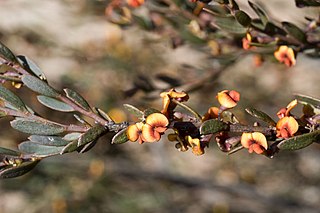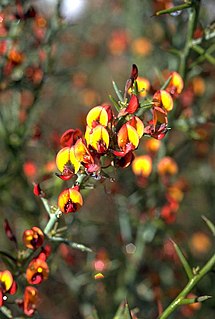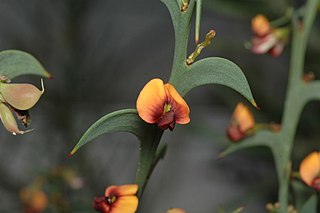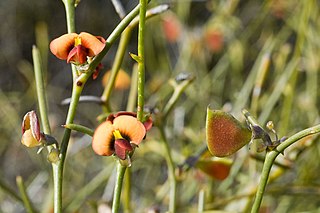
Daviesia horrida, commonly known as prickly bitter-pea, is a species of flowering plant in the family Fabaceae and is endemic to the south-west of Western Australia. It is a spreading shrub with rigid, spiny branchlets, narrowly elliptic phyllodes and orange and dark red flowers.

Daviesia hakeoides is a species of flowering plant in the family Fabaceae and is endemic to the south-west of Western Australia. It is a shrub with many tangled stems, scattered sharply-pointed phyllodes and yellow or orange and dark red flowers.

Daviesia argillacea is a species of flowering plant in the family Fabaceae and is endemic to the south-west of Western Australia. It is an erect, bushy shrub with erect narrow egg-shaped phyllodes with the narrower end towards the base, and yellow to orange and maroon flowers.

Daviesia articulata is a species of flowering plant in the family Fabaceae and is endemic to the south-west of Western Australia. It is a rigid, low-lying or erect shrub with scattered, tapering, cylindrical and sharply pointed phyllodes, and yellow and red flowers.
Daviesia benthamii is a species of flowering plant in the family Fabaceae and is endemic to the west of Western Australia. It is an erect, bushy shrub with scattered, cylindrical, sharply pointed phyllodes, and yellow-orange and reddish-brown flowers.

Daviesia brachyphylla is a species of flowering plant in the family Fabaceae and is endemic to the south-west of Western Australia. It is a spreading to bushy shrub with cylindrical phyllodes with a slightly downcurved point and orange, maroon and red flowers.

Daviesia crassa is a species of flowering plant in the family Fabaceae and is endemic to the south-west of Western Australia. It is a compact, dense, glabrous shrub with densely crowded, thick, club-shaped phyllodes, and uniformly yellow flowers.

Daviesia crenulata is a species of flowering plant in the family Fabaceae and is endemic to the south-west of Western Australia. It is a bushy shrub with broadly egg-shaped phyllodes with a sharply-pointed end and wavy edges, and uniformly yellow-orange and maroon flowers.

Daviesia debilior is a species of flowering plant in the family Fabaceae and is endemic to the south-west of Western Australia. It is a shrub with low-lying stems and many erect branchlets, scattered linear to scale-like phyllodes, and yellow, purplish, orange-pink and dark purplish flowers.

Daviesia aphylla is a species of flowering plant in the family Fabaceae and is endemic to the south-west of Western Australia. It is an erect, bushy shrub with glabrous foliage, up to six sharply-pointed phyllodes on each branchlet, and orange-red and yellow flowers.

Daviesia dilatata is a species of flowering plant in the family Fabaceae and is endemic to the south-west of Western Australia. It is an erect, open, glabrous shrub with scattered, often sickle-shaped phyllodes, and orange, red, yellow and dark crimson flowers.

Daviesia elongata is a species of flowering plant in the family Fabaceae and is endemic to the south-west of Western Australia. It is a glabrous, spreading or sprawling shrub with narrowly egg-shaped to linear phyllodes and yellow-orange and maroon flowers.
Daviesia eremaea is a species of flowering plant in the family Fabaceae and is endemic to central Australia. It is an erect, glabrous, multi-stemmed shrub with needle-like, more or less sharply-pointed phyllodes, and yellow and red flowers.

Daviesia genistifolia, commonly known as broom bitter-pea, is a species of flowering plant in the family Fabaceae and is endemic to south-eastern continental Australia. It is a glabrous, low to open shrub with scattered, sharply-pointed, cylindrical phyllodes and yellow or orange-yellow, deep red and maroon flowers.

Daviesia grahamii is a species of flowering plant in the family Fabaceae and is endemic to the interior of Western Australia. It is a multi-stemmed shrub with narrowly egg-shaped to linear phyllodes, and bright yellow to orange-yellow, dark red and maroon flowers.

Daviesia incrassata is a species of flowering plant in the family Fabaceae and is endemic to the south-west of Western Australia. It is an erect, mounded to spreading shrub with more or less zigzag branchlets, scattered needle-shaped phyllodes and orange, deep red and pink flowers.

Daviesia intricata is a species of flowering plant in the family Fabaceae and is endemic to the south-west of Western Australia. It is a glabrous shrub with densely tangled branches, sharply-pointed, needle-shaped or flattened phyllodes and apricot-yellow and dark red flowers.

Daviesia localis is a species of flowering plant in the family Fabaceae and is endemic to a restricted area of the south-west of Western Australia. It is an erect, spreading shrub with spine-tipped branchlets, scattered, spreading, curved, needle-shaped, sharply-pointed phyllodes and orange-yellow and red flowers with a v-shaped central mark.

Daviesia major is a species of flowering plant in the family Fabaceae and is endemic to the south-west of Western Australia. It is an erect, many-stemmed shrub with scattered, erect, sharply-pointed, cylindrical phyllodes and orange and red flowers.

Daviesia mesophylla is a species of flowering plant in the family Fabaceae and is endemic to the south-west of Western Australia. It is a low-lying, glabrous shrub with sharply-pointed, linear or narrowly egg-shaped phyllodes with the narrower end towards the base, and yellow to orange, red and cream-coloured flowers.


















